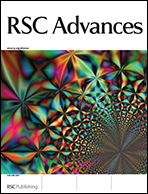Magnetic properties of 3d transition metals and nitrogen functionalized armchair graphene nanoribbon
Abstract
First-principles density functional theory (DFT) calculations were performed to study the stability and magnetic properties of TM–CxNy (TM = Sc, Ti, V, Cr, Mn, Fe, Co, Ni, Cu and Zn; x/y = 0, 1 and 2 and x + y = 2) edge defects in armchair graphene nanoribbon (9-AGNR). The results showed that the edge functionalization of 9-AGNR by TM–N2 defects is energetically more favorable compared to the edge functionalization by TM–C2 and TM–CN defects. Furthermore, we found that edge TM–CxNy defects in 9-AGNR support high and localized magnetic moments. The magnetic moment of TMs in TM–CxNy edge defects increases with an increase in the number of unpaired electrons in the 3d orbitals, and the calculated magnetic moment is largest for an edge Mn–N2 defect. The analysis of magnetization of TMs reveals that the magnetic moment mainly comes from the electrons in the 3d orbitals and the contribution of 4s electrons to the total magnetic moment is very small. Our calculations also show that the magnetic moment of TMs in edge TM–N2 defects in AGNR is independent of edge TM–N2 defect concentrations and AGNR width in the present study. The interedge magnetic coupling between the edge TM–N2 defects is explored by investigating the competing ferromagnetic and antiferromagnetic spin structures. We found that the interedge magnetic coupling depends on the type of TMs in edge TM–N2 defects and TM–N2 edge defect concentrations.


 Please wait while we load your content...
Please wait while we load your content...